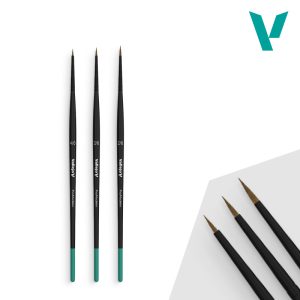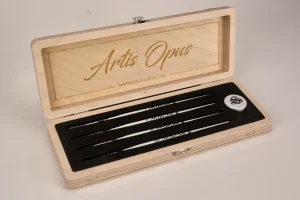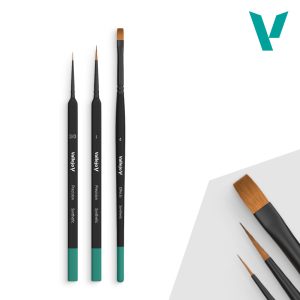When it comes to painting miniatures, having the right tools is essential to achieving a high-quality finish. One of the most important tools in your arsenal is your brush. The best brushes for painting miniatures can make a significant difference in your ability to create fine details, smooth blends, and crisp edges. In this guide, we’ll explore what makes a brush ideal for miniature painting, review some of the top brushes available, and provide tips on how to care for your brushes to ensure they last.
Why Choosing the Best Brushes for Painting Miniatures Matters
Using the right brushes can drastically improve your painting experience and the results you achieve. Here’s why it’s important:
- Precision: Miniature painting requires working on very small surfaces with fine details. The best brushes have a sharp point that allows for precise application of paint, whether you’re adding highlights, shading, or detailing tiny features like eyes.
- Control: High-quality brushes provide better control over your paint, allowing you to manage the flow and placement with greater accuracy. This is crucial for techniques like layering, glazing, and edge highlighting.
- Durability: Good brushes maintain their shape and point over time, even after extensive use. They resist fraying and splitting, which can ruin a paint job.
- Efficiency: Using the best brushes means you’ll spend less time correcting mistakes and more time enjoying the painting process. They help you achieve smoother blends and cleaner lines with fewer strokes.
Key Features to Look for in the Best Brushes for Painting Miniatures
When selecting brushes for miniature painting, consider the following features:
- Bristle Type: Brushes typically come with either natural or synthetic bristles.
- Kolinsky Sable: Often considered the gold standard for miniature painting, Kolinsky sable brushes are made from the hair of a species of weasel. They hold a sharp point, have excellent paint retention, and offer superior control.
- Synthetic Bristles: These are generally more affordable and can still provide good performance, though they may not last as long or hold a point as well as natural bristle brushes.
- Size: Brush sizes are indicated by numbers, with smaller numbers (like 00 or 1) being best for fine detail work, and larger sizes (like 3 or 4) being better for base coating or glazing. For most miniature painters, a range of sizes from 000 to 3 will cover most needs.
- Shape: The two most common brush shapes for miniatures are round and flat.
- Round Brushes: These are the most versatile and are used for the majority of painting tasks, including base coating, layering, and detail work.
- Flat Brushes: These are useful to cover larger surfaces quickly and evenly, and for techniques like dry brushing.
- Handle: The handle length and thickness can affect comfort during long painting sessions. Most miniature painters prefer short-handled brushes for better control, but you should feel free to experiment and find out what works best for you.

Top Picks for the Best Brushes for Painting Miniatures
Here’s a look at some of the most recommended brushes among miniature painters:
1. Artis Opus Series S and M
The brushes from Artis Opus’ S and M series are highly regarded in the miniature painting community for their precision and durability. The M Series is ideal for detailed work, while the S Series excels in blending and layering techniques. Made with Kolinsky sable hair, these brushes retain a fine, sharp point, offering excellent control during painting. Although they come with a higher price tag, their quality and performance make them a valuable investment for serious painters.
- Best For: Detailed work, blending, and layering.
- Available Sizes: From 000 to 6.

2. Raphael 8404
Another top-tier Kolinsky sable brush, the Raphael 8404 is praised for its slightly longer bristles compared to the Winsor & Newton Series 7, which gives it a bit more flexibility. These brushes are also slightly more affordable but still deliver professional results.
- Best For: Detail work, blending, and glazing.
- Available Sizes: From 000 to 6.
3. Rosemary & Co Series 33
Rosemary & Co’s Series 33 brushes are a popular choice among miniature painters for their excellent quality and more affordable price point. They offer great control and are particularly praised for their resilience and ability to hold their shape over time.
- Best For: General-purpose painting, detail work.
- Available Sizes: From 000 to 4.
4. Da Vinci Maestro Series 10
These brushes are another excellent choice for those looking for high-quality Kolinsky sable brushes. Da Vinci Maestro brushes are known for their strong points and consistent performance, making them ideal for both beginners and experienced painters.
- Best For: Fine detail, base coating, and highlighting.
- Available Sizes: From 000 to 6.
5. Vallejo Synthetic Brushes
Vallejo’s synthetic brushes are a popular choice among miniature painters who seek affordable tools without sacrificing too much quality. These brushes offer good elasticity and durability, making them ideal for base coating, applying thicker layers, and techniques that require more wear and tear. While they are not made from natural hair, they maintain their shape and provide consistent performance over time, making them perfect for beginners or as workhorse brushes for less delicate techniques.
- Best For: Base coating, thick layers, and general techniques.
- Available Sizes: From 000 to 6.

Caring for Your Brushes
To get the most out of your brushes, proper care is essential. Here are some tips to keep your brushes in top condition:
- Prevent paint from getting into the ferrule: The metal part that holds the bristles together is called the ferrule. You should never dip your brush more than halfway through the bristles into the paint so you can prevent any paint from getting into the ferrule, as this would eventually cause the tip of the brush to split beyond repair.
- Clean Your Brushes After Every Use: Use warm water and a gentle brush soap to clean out any remaining paint. Avoid letting paint dry on the bristles as it can ruin the brush.
- Shape the tip: After cleaning, reshape the bristles to their original point and let the brush dry horizontally to prevent water from seeping into the ferrule (the metal part that holds the bristles).
- Store Brushes Properly: Store your brushes with the bristles facing up in a jar or use a brush holder to prevent damage to the tips.
Conclusion
Choosing the best brushes for painting miniatures can significantly enhance your painting experience and results. Whether you’re just starting out or looking to upgrade your tools, investing in high-quality brushes like the Artis Opus Series S and M or Raphael 8404 can make a huge difference in your ability to create stunning, detailed miniatures. Remember, taking good care of your brushes will also extend their lifespan, ensuring you get the most value out of your investment. Happy painting!
